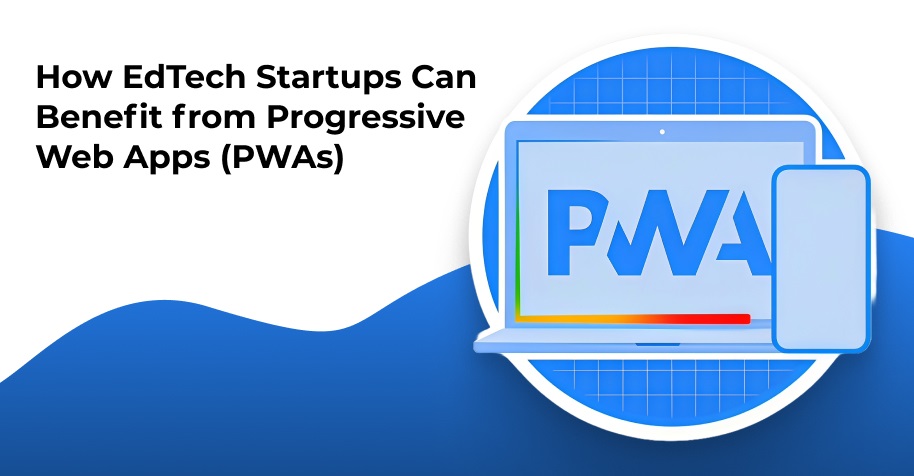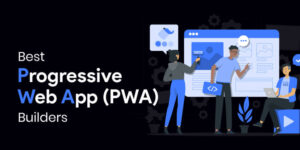
Progressive Web Applications (PWAs) are changing the way EdTech startups provide learning experiences. They merge the best of web and mobile applications; speedy, dependable and captivating. In this blog, we will discuss the ways in which PWAs can be used to help education startups grow more intelligently, increase user interaction, and make learning more accessible to students in any location.
Education is changing more than ever. Technology has transformed classrooms into a cyber world, and learning does not end when the school bell goes off. Students are able to study anywhere; on phones, laptops or tablets whenever they feel like being curious.
But there is a challenge that comes with this change. EdTech startups should provide solutions that are easy to use, and at the same time, fast, reliable, and accessible on all devices. Old applications are not that good; they are heavy to install, expensive to maintain and need continual upgrades. That is where Progressive Web Apps (PWAs) come in.
PWAs are currently reshaping the online education process. They load within seconds, can be used offline, deliver notifications, have a native-app-like experience, and do not make the user visit an app store. It offers frictionless learning to students and teachers, and cost-effective accelerated growth to startups.
What Is a Progressive Web App (PWA)?
A Progressive Web App is a web-based application that combines an app with a web portal. It operates in a web browser, and it is like a native application on your phone. You can install it from your browser, use it on your home screen and even offline.
PWAs are created with the help of web technologies, such as HTML, CSS, and JavaScript, though enhanced with other more sophisticated functions, such as caching, push notifications, and background sync. They are fast, light, and reactive, which are suited to the mobile-first user group of learners.
This secure architecture makes PWAs a reliable approach for institutions investing in modern learning tools and Education Software, offering peace of mind while maintaining seamless access and performance.
PWAs can also be launched directly through a browser connection with no need to be approved by the App Store or Play Store, unlike traditional applications. There is no need for installations and no waiting period, just instant access to education content.
It is game-changing for EdTech startups that are based on rapid adoption and engagement.
Adopting Progressive Web Apps (PWAs): How EdTech Startups Can Benefit?
1. Accessibility and Reach — Learning for Everyone
- Breaking Barriers to Learning:
Not all students have access to an expensive smartphone or have access to good internet. Progressive Web Apps equalise the playing field by offering lightness and portability across all devices. They work well even in older phones and slow networks, thus making education inclusive and universal.
- Reaching Every Corner:
A learner can take classes, assignments and resources without huge downloads regardless of whether they live in a metro city or a remote town. For EdTech startups, it means serving a wider audience and achieving the purpose of educating everyone.
2. Offline Learning Made Possible

- Learning Without Internet:
PWAs rely on service workers, which is a background technology that stores important content that can be accessed offline. This enables students to read their lessons or view downloaded lectures even when there is an internet failure.
- Continuous Learning Anywhere:
Students can study without distraction in rural areas or during their commute to school. For startups, this feature will result in an improved learning experience and reduced drop-offs caused by poor connectivity.
3. Lower Development and Maintenance Costs
- One Codebase for All Platforms:
Native applications need to be developed individually on Android, iOS, thus expensive and time-intensive. PWAs, in contrast, operate anywhere with a single codebase.
- Saving Time and Money:
By having a single development team to sustain the app, EdTech startups save on large costs and push updates quickly. This allows them to devote more time to better content and interaction with students rather than having to deal with several versions.
4. Seamless User Experience (UX)

- App-Like Feel, Browser Simplicity:
PWAs provide a native-app-like experience in a browser. They load quickly, react in a second, and fit any size or orientation of the screen.
- Quick Access and Better Engagement:
Students are able to add the app to their home screen and do this within seconds. This convenience saves time and ensures that learners remain active, teachers have easy uploads, grading, tracking, and performance hiccups do not occur.
5. Faster Load Times = Better Retention
- Speed Defines Success
Learners will not tolerate sluggish programs. Any app that takes over three seconds to load shows a majority of users leaving. PWAs address it through smart caching and preloading.
- Instant Access Builds Trust
Elements that have been visited are stored locally and are thus accessible immediately, even in poor connections. Quick response demonstrates consistency that develops student confidence and sustained interest.
6. Engagement Through Push Notifications
- Keeping Students in the Loop:
Among the biggest difficulties EdTech startups experience is learner engagement. PWAs support push notifications to update learners, announce upcoming classes, and provide progress updates directly on users’ devices.
- Boosting Retention and Motivation:
Timely, smart notifications help to create a regular study schedule and engagement. Teachers are also able to send short reminders or push-ups, keeping the platform alive and in touch.
7. Easy Updates and Maintenance
- Goodbye, Manual Updates:
Native applications require users to manually update them, which is not something many users do. PWAs automatically update in the background, so everybody is always on the latest version.
- Faster Rollouts, Happier Users:
For startups, this means bug fixes, new lessons, or improvements in UI being rolled out without disrupting the flow. It maintains consistency, continuity, and comfort for all the learners.
8. Improved Security and Reliability

- Protecting Learner Data:
Education applications store sensitive information, such as progress reports, personal data, and payments, and PWAs are designed to be secure. They are based on HTTPS, which guarantees the integrity of data and protection against threats.
- Consistent Performance, Trusted Learning
Browsers and service workers provide trusted experiences. It will result in reduced crashes, reduced downtimes, and a reputation for quality and safety, important to any emerging EdTech company.
9. Better Discoverability and SEO Advantage
- Easier to Find, Easier to Grow:
PWAs are web-based, unlike native apps that are only seen on app stores and thus are entirely searchable on Google. An effective SEO approach will draw students who are looking at online courses or tutoring websites.
Organic Traffic Meets App-Like Experience:
PWAs allow you to enjoy the best of both: search engine popularity and high engagement. You can find users via search and keep them with the app-like usability of your PWA.
10. Scalability for Growing User Bases
- Built to Handle Growth:
Scalability is the dream of every startup; however, conventional applications can easily collapse during a traffic surge. PWAs are lightweight and browser-based and are efficient in large user volumes.
- Performance That Grows with You:
PWAs provide stable performance during exams, live classes, or mass onboarding without expensive rebuilds using cloud support and caching mechanisms.
The Future of EdTech Lies in PWAs
The education industry is heading to an era where education will be instant, inclusive, and immersive, and PWAs will spearhead the change. These are strong, web-based applications that allow students to access lessons at any time, no matter where they are, without any concern about downloading or storage capacity.
For EdTech startups, PWAs unlock the ability to scale rapidly while keeping costs low and performance high. They act as a bridge between accessibility and innovation, empowering education platforms to expand globally with ease. With the right Education Software development strategies, PWAs help deliver seamless learning experiences to diverse learner groups across the world.
With the technological advancement, PWAs will form the basis of more intelligent and tailored learning experiences in all digital classrooms.
Conclusion
The future of EdTech is being reshaped through Progressive Web Apps, which are a combination of speed, simplicity, and accessibility. They allow startups to serve more learners, lower the costs of maintenance, and provide consistent and high-quality user experiences.
For students, PWAs eliminate friction and enable them to learn anywhere, online or offline. To teachers and startups, they provide the flexibility and long-term scalability. With the rise in digital education, the move towards PWAs is not only a brilliant idea, but it is also the only way to remain relevant and competitive.
The future of EdTech lies with the people who are not afraid of innovations and can use technology as an opportunity, not an obstacle, to superior learning.






